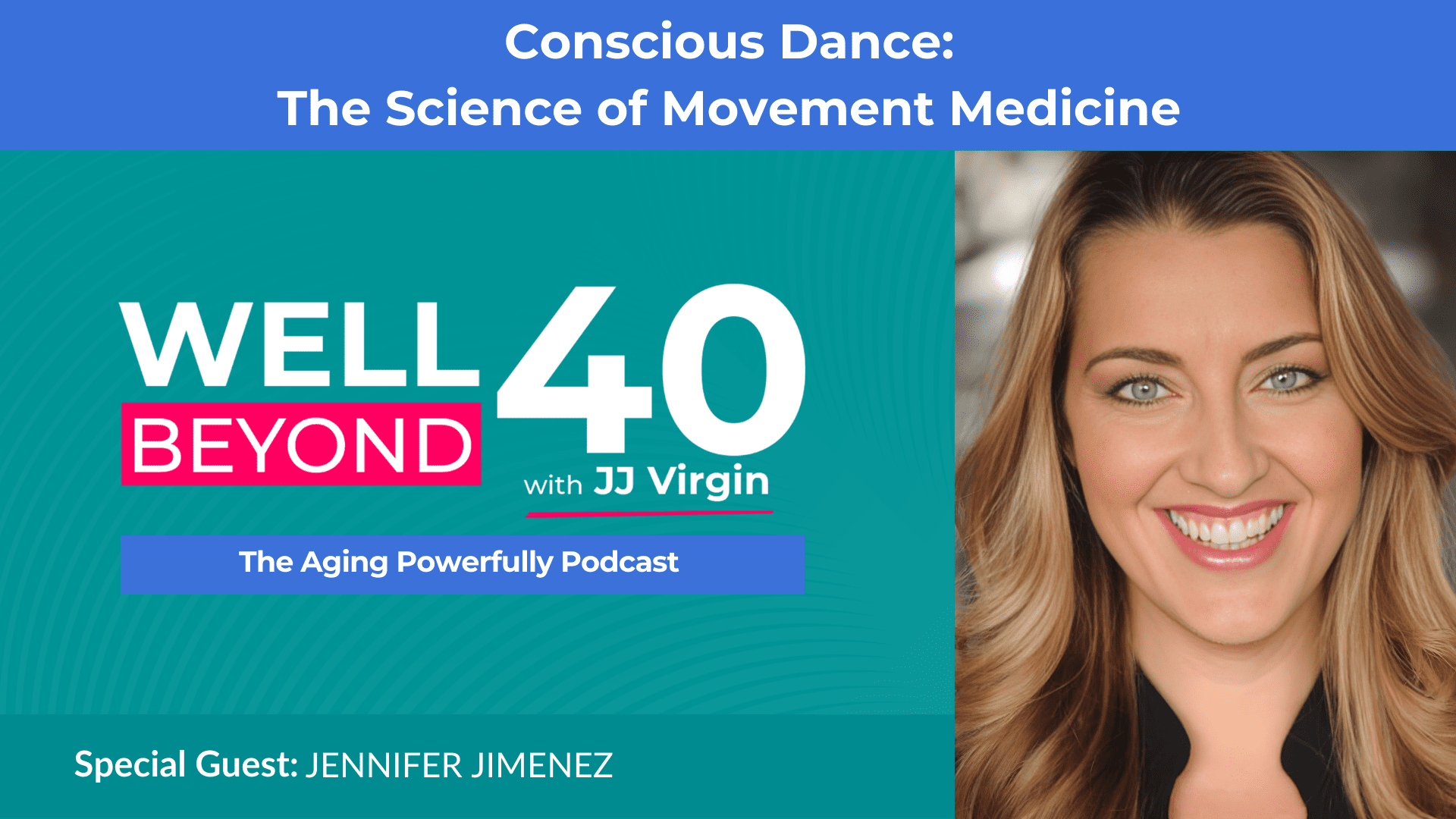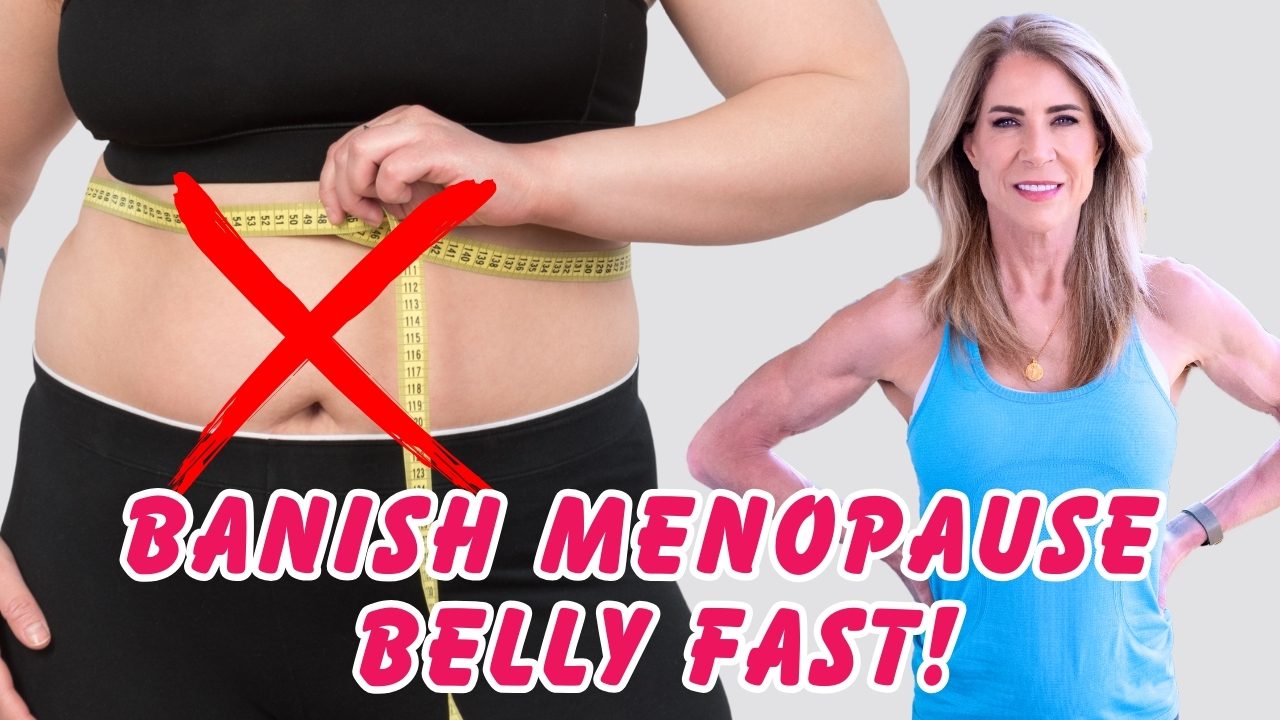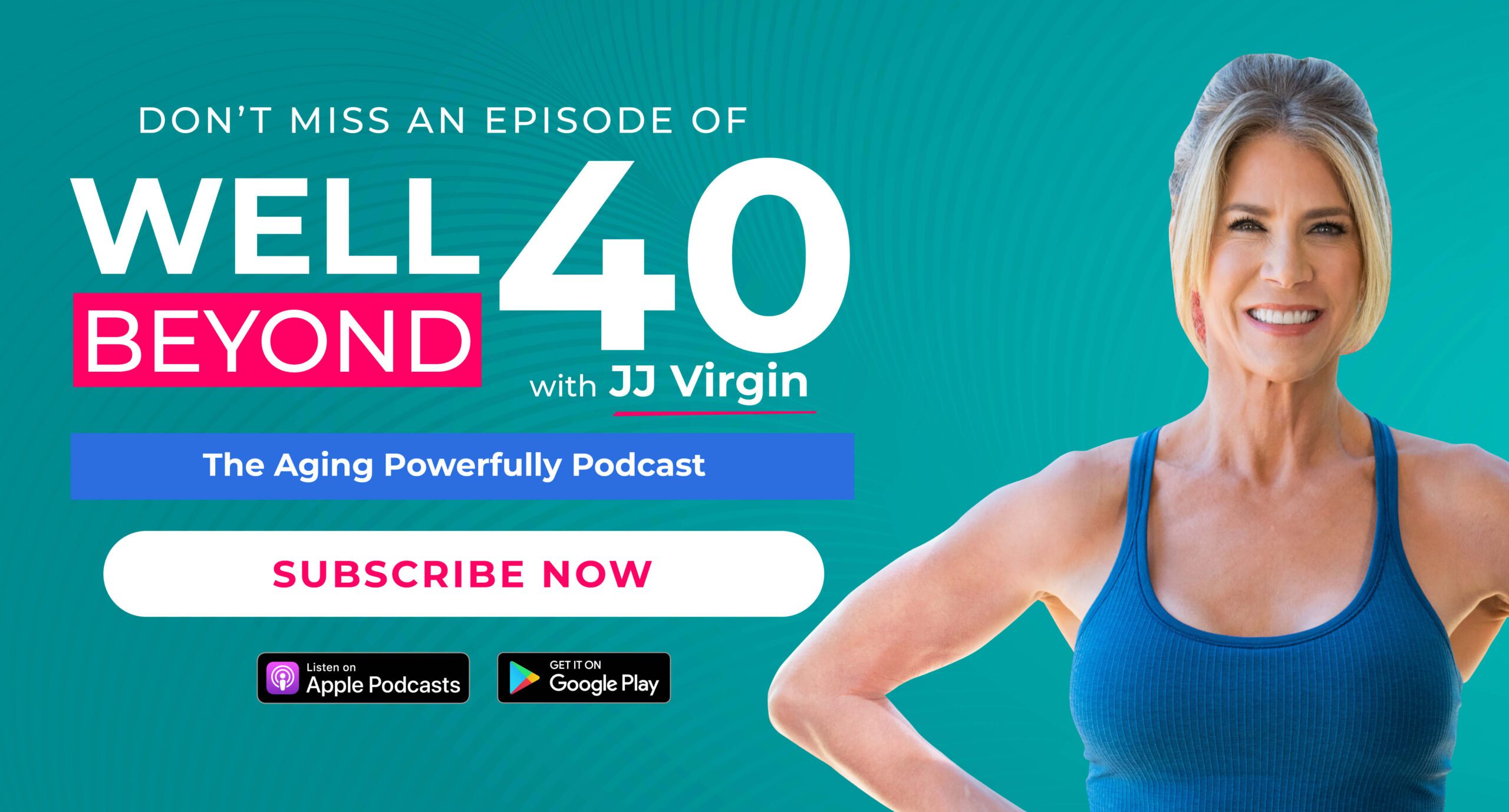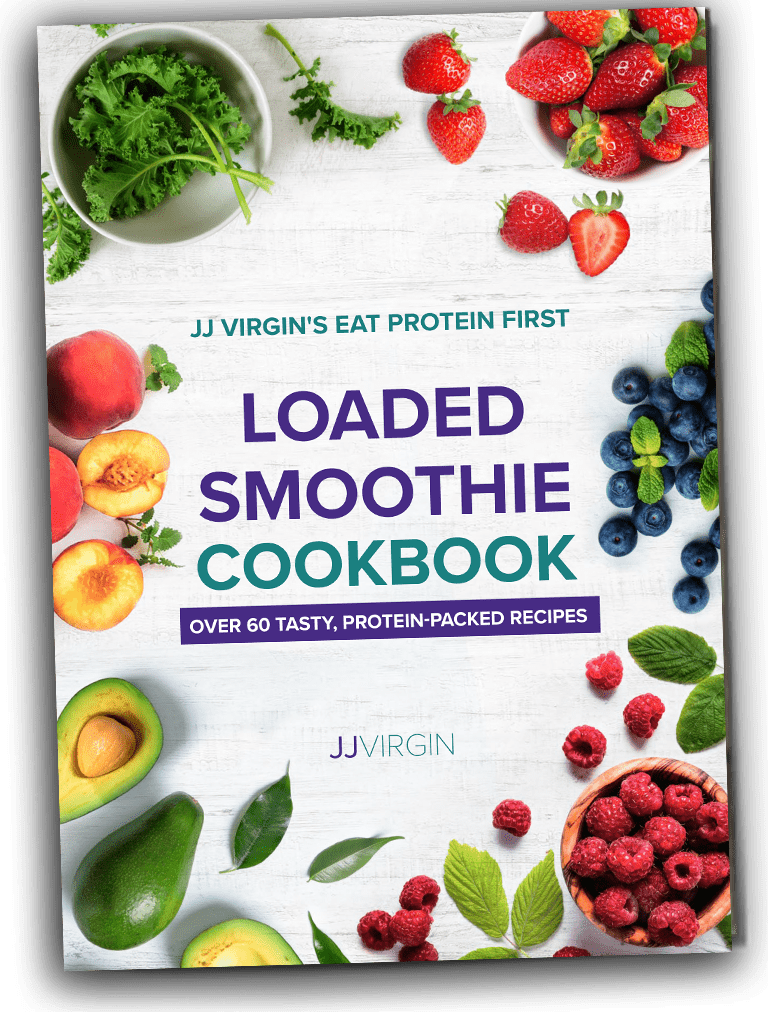Why Building Muscle Is Your Most Powerful Anti-Aging Strategy
In this game-changing episode, I’m challenging everything you thought you knew about exercise after 40. Forget the old rules about cardio being queen – I’m sharing why resistance training is actually your secret weapon for burning fat, building stronger bones, and even creating new brain neurons. Drawing from my background in Exercise Physiology at USC and the latest research, I break down why it’s never too late to start lifting weights (yes, even at 85!), and how to begin safely and effectively. You’ll discover why those gym machines aren’t just for twentysomethings, and how building muscle becomes your metabolic superpower. Plus, I reveal the surprising truth about getting “bulky” (spoiler alert: it’s probably not what you think), and share my fool-proof strategy for starting your strength training journey today.
What you’ll learn:
- Why resistance training trumps cardio for fat loss, heart health, and longevity after 40
- The fascinating science behind myokines and how they boost brain health and immunity
- Essential baseline measurements to track your strength training progress
- A practical breakdown of the three main movement patterns for total body transformation
- How to progress safely from beginner to advanced resistance training
- The truth about muscle building for women over 40 and why “getting bulky” is a myth
- The optimal combination of resistance training and daily movement for best results
Love the Podcast? Here’s what to do:
Make My Day & Share Your Thoughts!
- Subscribe to the podcast & leave me a review
- Text a screenshot to 813-565-2627
- Expect a personal reply because your voice is so important to me.
Join 50,000+ followers who make this podcast thrive.
Want to listen to the show completely ad-free?
- Go to subscribetojj.com
- Enjoy the VIP experience for just $4.99/month or $49.99/year (save 17%!)
- Click “TRY FREE” and start your ad-free journey today!
Resources Mentioned in this episode
Download my free Resistance Training Cheat Sheet
Episode Sponsors:
Try Timeline. Use code JJ10 for 10% off all products
Try Qualia risk free for up to 100 days and code VIRGINWELLNESS for an additional 15% off
Forget cardio, strength training is the real fountain of youth after 40. All right, cardio bunnies, I know already what you’re thinking, but if I want to lose weight, I got to burn a bunch of calories. I need to do a lot of cardio. Or maybe you’re stuck in the 80s and 90s, like what I was literally taught in graduate school, that before you lose the weight, don’t lift weight.
And if you’re also thinking, oh, but I need a strong heart, and yes, that’s true. You want to have a good VO2 max, it is actually the biggest predictor of all cause mortality, but it turns out for all of these things. Resistance training is actually the most effective form of exercise. Okay, hear me out on this.
First of all, resistance training is going to put more muscle on your body. More muscle on your body burns more calories overall, helps you become more insulin sensitive, and helps you burn fat better. So, that’s the first big bonus. The second thing is when you do resistance training, it actually helps you improve your VO2 max, and it’s also good for your heart.
So, you can get a better heart, you can get better cardiovascular function from doing resistance training. In fact, if you put the two together, aerobic training and resistance training, it’s even better. So while I said forget aerobic training, I’m going to say if you only have time to focus on one, focus on resistance training.
But of course, you’re also moving more and doing cardio throughout the day because you’re walking. So we’re getting both of those things in. So the deal is, as we age, we’re losing muscle. But you can get rid of that a lot if you do the resistance training. So we want to do resistance training because it’s great for our heart.
We want to do resistance training because it’s good for our muscles and bones. And we also want to do resistance training because it’s great for our brain. When you do resistance training, when those muscles contract, they release these messengers called myokines. And myokines, we’ve now discovered there’s over 600 different types of these myokines.
And some of the cool things that myokines can do is they can help you make new brain neurons. They can improve your mood. They can help you become more insulin sensitive. They can boost your immune system. They can lower systemic inflammation. And I could literally go on and on and on. All of this to convince you that if you have forgotten to lift weights, I always say, if you forgot to lift weights.
This whole time. It’s time to start. And if you’re thinking, Oh my gosh, well, it’s too late to start more good news for you. It is never too late to start. In fact, they just did a study where they looked at 65 year old and 85 year old and found that both of them equally could get strong and put on muscle.
And I think back to my grad school days when I was in the Department of Exercise Physiology. at USC and they were doing research on 90 year old athletes and finding that they were having great results. So it is never too late to start. And the best time to start if it wasn’t last year is right now. So if you’re ready to start, what do you need to do?
All right. First thing that I’d love you to do is get a baseline, a baseline of your muscle mass and your bone density and where your fat is located and a baseline of your strength. So the first thing that you do is you go get something called a DEXA scan. And a DEXA scan is going to look at, we’ve done it for years for bone marrow density, but also it looks at your skeletal muscle mass and your body fat and how much visceral adipose tissue you have.
Now, if that is not available to you, then at least do a bioimpedance machine at home that looks at your total body water. And then from that, That makes a projection of how much body fat and how much skeletal muscle you have because we have to do something so that we can track your progress. The other thing that I want you to do is test your basic strength and endurance.
Here’s an easy, easy way to do this. Push ups. Yes, push ups. So, we will put in the notes the norms for push ups, where you want to be. But basically, what I want you to do is, in good form, coming down to almost touching your chest and your nose, do push ups until you can’t do them anymore in good form, and see how many you can do.
And that’s going to be your baseline. Bonus points, if you can also get yourself a hand grip dynamometer, that’s what they’re called, easy to find on Amazon, cost about 30, and test your grip strength in both hands. And what I want you to do is use this as your starting number because one thing you’re going to find as you start to do resistance training is that your strength is going to increase very quickly.
It can be super inspiring. Your muscle mass is going to take a while. But your strength increases pretty quickly, because it’s something that happens within your central nervous system. So you’re going to start lifting weights. You now know your foundation for your muscle mass and body fat. You know your foundation for your strength.
And one more thing you could do for strength is you could do a pull up or a flexed arm hang. That’s another great one, because grip strength, it turns out, is a very good predictor of all cause mortality. Meaning, if you are in the lowest quartile for grip strength, you are in the highest risk for all cause mortality.
So that hand grip dynamometer is one way to test, or you can see if you can do a pull up. Or if not, if you can just stay in a flexed arm, hang and hold it. And how long you can hold it for. So those are all the different ways that you can test. They’re easy enough to do, but you really want to do that to start.
Cause it’s so motivating as you do this to see how much you progress. Now, I like to say that you train. to get better at life. You do not train to get better at training. So I’m going to walk you through some of the exercises that I want you to do. These are things that you can do at home. So if you’re one of those people that says, I don’t want to go to the gym, or you might say I’m too out of shape to go to the gym, then you can do all of this at home.
If you would rather do this at a gym and use machines, here’s the reality. You can build as much muscle on using machines as you can using free weights. Machines are a little bit safer in most cases than free weights. However, I like to do more compound free weight, full body movements because it’s going to pull in more of my core.
And it’s going to help me mimic activities of daily living better. So, ideally at some point you’re going to start to do more of these free weight, body weight type of exercises I’m going to show you. So, I divide the body into four parts and then I’m going to focus on actively training three. They are upper body pushing.
So upper body pushing, the example would be something like a push up. And when I do these exercises, I like to do them both in a horizontal plane. So that would be like a push up and a vertical plane, like an overhead press. And I’m using my chest. My shoulders, back of my arms, my triceps for that. If you’re looking at getting better arms, because I get asked this all the time, I focus on solely compound movements.
Because every time I’m doing a pushing exercise, I’m going to use my triceps. Every time I’m doing a pulling exercise, I’m going to use my biceps. If you see me working out You will not see me doing bicep curls or tricep extensions because I’m doing full compound movements instead where I’m working those muscles, but in conjunction with other muscles too.
So, upper body pushing, upper body pulling are things like bent over rows. upright rows, pull downs or pull ups, and that’s using my lats, that’s using my shoulders, that’s using my biceps. Then there’s hip and thigh hinging, and those are things like squats, step ups. lunges, deadlifts. And then of course there’s core.
However, I will tell you that I rarely do straight core exercises like sit ups because I do push ups and I do pull ups. And I do squats, so I do things that pull my core in, so I’m actively working my core in a very functional way, the way I would do in life. So I focus on those three body parts, pushing, pulling, hip and thigh hinging, and using my core all throughout.
If you’re first starting out, the most important thing If you can do it, get yourself a trainer to take you through the motions. And this is where a gym can be great because quite often when you sign up for the gym, they’ll give you a training session as part of the introductory package, which can be fantastic to help you get started.
If you are not sure what to do, I’d rather err on the side of caution and use machines to begin with because the thing we want to avoid at all costs is injury. Having said that, the place where you’re most likely to get injured It’s not in the gym. It’s in the wild. It’s in real life. We work out in the gym so that we don’t get hurt in real life.
And that’s why the more you can mimic normal activities of daily living, the better off you’re going to be when you get out of the gym. So things that I would have you start to start out with are Just going through the motions to begin with with body weight to start and doing, picking each area and doing one to two exercises within each area and doing two easy sets to start.
So for hip and thigh hinging, that may mean to start with, you just do a set of air squats over a chair, 10 repetitions, two sets. You may do a step up onto a bench or onto a stair, up and down. Two sets for upper body pulling might be a bent over row and an upright row and using really light weights, which means at home you could be even using water bottles to start.
or cans to start, and then push ups, which, depending on where you’re starting, they can be on your knees, it could be against the wall, just needs to happen, and upper body pushing. You do your first time of that, and then you see how you feel. And I would always rather you err on going a little bit too easy to start, than going so hard that you’re super sore.
I remember when I First, I started to learn all the different ins and outs of resistance training and one of my friends from one of the aerobics classes I taught wanted me to take her to the gym. So I did. I took her to the gym for two hours and I went through every exercise that I’d learned in, in my exercise phys class.
And she was literally in bed for a week. This was the wrong way to go. I’m surprised she ever got up and got into the weight room again. I’m surprised she actually ever talked to me again. But you want to start out easy and then build on it. Because when you’re first starting to do resistance training, what actually happens first is that you are activating your central nervous system.
You’re getting your nerves and your muscles to talk to each other and learn those movements. Right? So form is everything. If you have to sacrifice form, you need to stop. Right, that’s the limiter. So that’s where you start. Now as you’re going, it takes the first couple weeks as really your central nervous system, your muscles and nerves talking to each other.
You’ll notice a big leap in strength, but you won’t really start to see any muscles happening. The next thing that starts to happen is your connective tissue is getting stronger because generally when you get injured, it’s not a muscle tearing. It’s where the muscle and the tendon connects. or it’s where the ligament’s connecting to the bone.
It’s where these things are connecting. It’s not the muscle per se. So you want to make sure that you’re building slowly from it. So generally what I like to do is the first week, lightweight, two sets, somewhere in the 8 to 15 rep range, and see how you feel and do Now, when we first start, we’re really focusing on building muscle and the range to build muscle.
You’ve got an exercise when you do an exercise and you do repetitions of that exercise. Like, let’s say you’re doing pushups. If you do 10 pushups, that’s called a set. The 10 pushups are called repetitions. So 10 repetitions of pushups is one set of pushups. Turns out to build muscle, you can work anywhere between 6 repetitions all the way up to 30 repetitions.
And so it really depends on personal preference. Although I would really emphasize that I’d rather see you working on the lower end of the scale, somewhere in the 6 to 12 repetition range. And as we progress, I’m going to even push you to go lower than that, which we’ll talk about in a moment. So that’s where we’re going to start.
Easy peasy. The next week we’re going to take it up a little bit. You’ll do that first set easy like before, but then we’re going to make it medium. So let’s say that you were doing overhead presses the first week and you were holding cans the first week. The next week you do a one set with cans and maybe now you’ve got Five pound dumbbells in each hand and it feels medium hard.
And notice that I’m doing overhead presses standing up because in life, we’re not bolted to the floor. We’re standing. You want to continue to progress that week medium and do two rounds, two sets of medium. And then we’re going to progress past that. And each week as you start to progress, you are going to get to the point where now all of a sudden it feels hard.
And so here’s the reality, and this especially is for women, we tend to underestimate what we’re capable of. That’s kind of a metaphor for us in life, right? And it’s time for you to really step into your power. And so what you’re going to find is that quite often we don’t push ourselves as much as we’re capable of.
There’s a concept in weight training called reps and reserve. And it’s based on something called your One Repetition Max. And your One Repetition Max is if you could only do something one time, which is an absolute test of your strength, how much could you do? That’s your One Repetition Max. Then there’s reps in reserve.
Let’s say that I did ten, ten reps of a push up, but I could have done two more in good form. Those are two reps in reserve. When you’re doing resistance training, you really want to make sure you’re getting to a point where you have maybe one or two reps in reserve before your form would go. It’s not that you can’t lift the weight anymore, it’s that you can’t lift the weight in good form.
That’s the limiter. Never sacrifice form to go heavier. So what we want to work into in the first couple of weeks is getting to the point where you’re lifting weights two to three times a week with at least a break of 24 hours. So if you lift it on Monday, you do it again on Wednesday. and you’re getting to a point where you only have one or two reps in reserve.
That’s what we want to work to. And then doing a warm up set and two to four hard sets. That’s the goal for building muscle. As we age, we lose muscle, but we lose strength more than muscle, about two times more, and we lose power even more than strength. So, strength is the heaviest thing you can lift one time.
Power is how fast you can move something. As you start to progress, say about 3 or 4 months in, what I’d love you to start doing is work at the lower end of the scale as much as possible. Doing 6 repetitions, 5 repetitions as hard as you can, because that’s going to help you build more strength. Then, I want you to also add in a little bit of speed.
Because the speed’s going to help you with power. And that power is the biggest thing that we tend to lose. And remember, power is how fast you can do something. So, it may be that we’re doing a squat. You come down slowly, but you explode up as quickly as possible. And that’s how we incorporate in that power.
The other thing that we’re going to want to start incorporating in at the end of a couple of months is adding in a little bit of power in the form of like explosive jumps or explosive movements. So that could be something like adding in a kettlebell swing or jumping up onto something. But that’s just something to put into the back of your mind that you know is coming in 3 to 4 to 5 or even 6 months down the road as you get this really solid foundation.
Here’s the things that you’re going to start to notice as you’re doing this. Number one, you’re going to notice your strength improving pretty quickly. Like, let’s say you started out and you were using two cans to do overhead presses, then all of a sudden you went to five pound dumbbells. You might notice that over the course of three months, you went from using five pound dumbbells and overhead presses to 10 or 15 pound dumbbells, basically doubling or tripling your strength.
That’s pretty normal. But what you won’t see is huge changes in your muscle mass. And I tell you this because I hear so often, Oh, I don’t want to do this because I’m afraid I’m going to get bulky. It’s very hard for us to build muscle. We’re going to want to make sure that we’re getting the protein that we should be eating.
Seen my other videos about that, that you’re doing creatine to help you support lifting harder. But even with that, you’ll be lucky to put on a half pound to a pound of muscle a month. And muscle really is like metabolic spanks. It holds everything in tighter. So, if you’ve been worried about getting bulky, do not worry about that.
Here’s the biggest thing with that. If all of a sudden, after a couple months of lifting weights, you went, wow, I don’t like how toned and, uh, defined my arms are looking. said no one ever by the way you would just back off but i will tell you in 40 years of helping people lift weights i’ve never once seen it happen so maybe you’ll be the rare unicorn out there i doubt it so that is how you do the resistance training that’s how you walk into it i do have a resistance training cheat sheet to help you with it but it’s really pretty basic and simple the most important key thing here is the consistency of it.
Now, the title of this video really was forget cardio. But here’s the reality. I want you to prioritize resistance training and make sure you’re getting activity in all throughout the day as well. What I don’t want you to do is start adding in the resistance training and then going. And flopping on the couch.
So the other side of this is to make sure that you’re moving more all throughout the day. 8, 000 steps a day should be your foundational baseline. And more is always better. But don’t do more walking in place of resistance training. Make sure you get in the 8, 000 steps. But if you have extra time, let’s prioritize the resistance training.
Because the resistance training is really what’s going to make that big difference for you. It truly is your fountain of youth. Now, think about who you have who would benefit from this as well, because you know what? This is way more fun to do with a workout buddy. So share this video with a workout buddy.
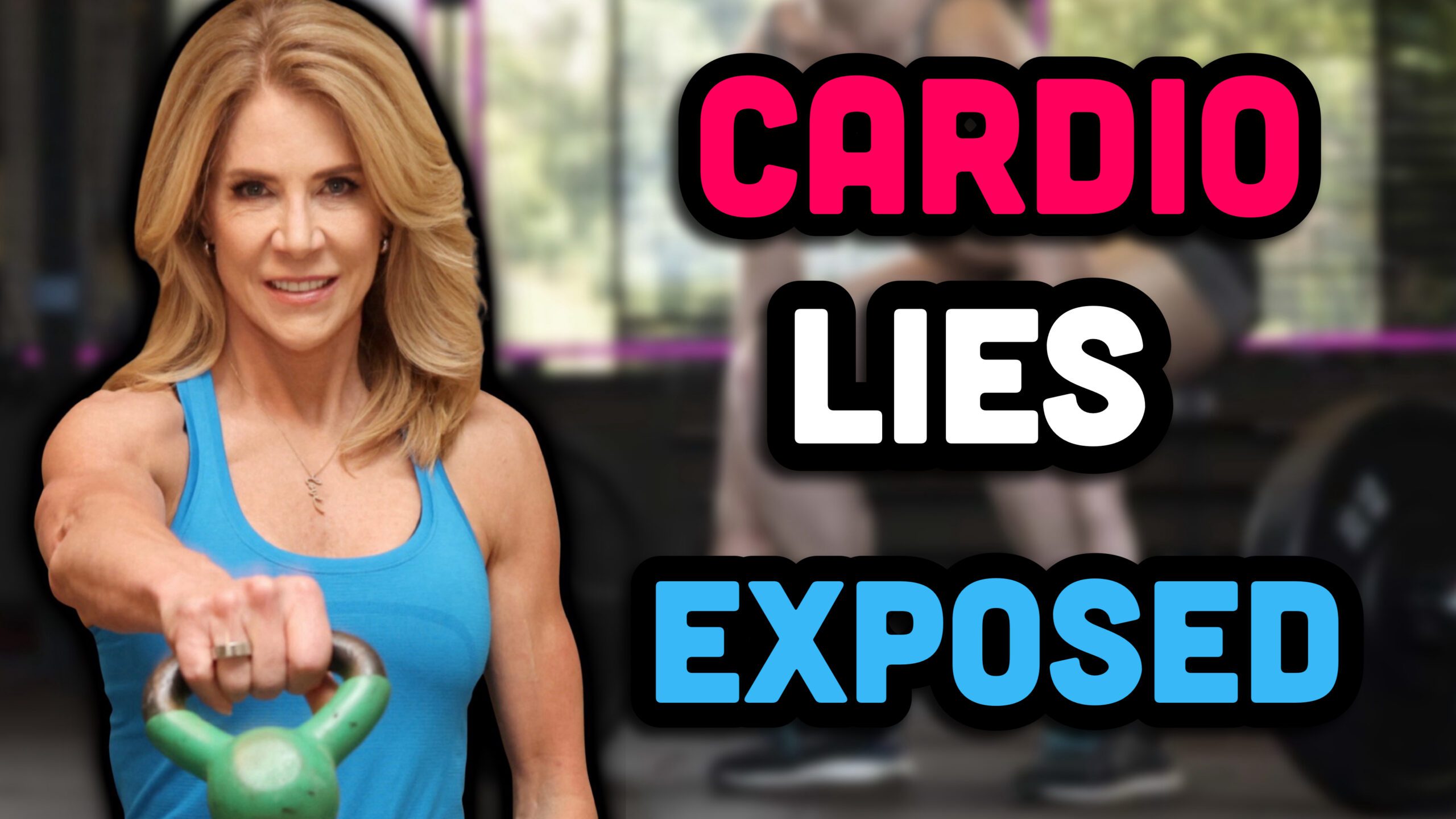
 Subscribe to our show
Subscribe to our show 